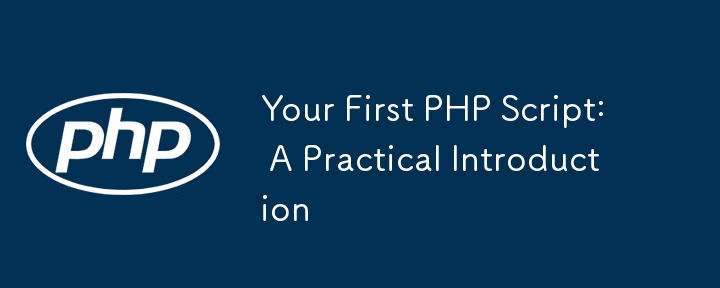Your First PHP Script: A Practical Introduction
Jul 16, 2025 am 03:42 AMHow to start writing your first PHP script? First, set up the local development environment, install XAMPP/MAMP/LAMP, and use a text editor to understand the server's running principle. Secondly, create a file called hello.php, enter the basic code and run the test. Third, learn to use PHP and HTML to achieve dynamic content output. Finally, pay attention to common errors such as missing semicolons, citation issues, and file extension errors, and enable error reporting for debugging.

So you've decided to try writing your first PHP script — good choice. PHP might not be the newest language on the block, but it's still widely used, especially for web development. If you're aiming to build dynamic websites or interact with databases, PHP is a solid tool to have in your kit.

Let's cut to the challenge and walk through what you actually need to get started with your first working PHP script.
Setting Up Your Environment
Before you write any code, make sure your system is ready. PHP runs on a server, so unlike HTML or JavaScript, you can't just open a .php file in your browser and expect it to work.

Here's what you need:
- A local server environment : Tools like XAMPP (Windows/Mac), MAMP (Mac), or LAMP (Linux) let you run PHP locally without needing an actual web host.
- A text editor or IDE : VS Code, Sublime Text, or PHPStorm are popular choices.
- Basic understanding of how servers work : You'll place your PHP files in a specific folder
htdocslikehttp://localhost/your-file.php.
Once installed, test your setup by creating a simple PHP file and loading it in your browser.

Writing Your First Script
Now that your environment is ready, let's write something basic but useful. This script will display a message and show how PHP handles variables and basic logic.
Create a file called hello.php inside your server directory and add this:
<?php $name = "World"; echo "<h1>Hello, $name!</h1>"; ?>
Open your browser and go to http://localhost/hello.php . You should see “Hello, World!” in heading style.
What's happening here:
- The
<?php ... ?>tags tell the server to treat everything inside as PHP code. -
$nameis a variable holding the string"World". -
echooutputs HTML content back to the browser.
This may seem simple, but it demonstrates two key concepts: storing data and outputting it dynamically.
Mixing PHP with HTML
One of PHP's strengths is its ability to seamlessly mix with HTML. You don't have to choose between generating HTML or processing logic — you can do both in the same file.
Here's an example where PHP decides what message to show based on the time of day:
<!DOCTYPE html>
<html>
<head><title>Greeting</title></head>
<body>
<?php
$hour = date('G');
if ($hour < 12) {
echo "<p>Good morning!</p>";
} else {
echo "<p>Hello there!</p>";
}
?>
</body>
</html>This script does a few things:
- Uses
date()to get the current hour. - Checks if it's before noon and displays a different greeting accordingly.
- Outputs HTML from within PHP blocks.
You can switch back and forth between HTML and PHP as needed — just remember to close and reopen the PHP tags properly.
Common Pitfalls and Tips
Even small mistakes can break your script. Here are a few common issues beginners run into:
- Forgetting semicolons at the end of each PHP statement.
- Mixing up quotes and variables — double quotes allow variable interpolation; single quotes don't.
- Not checking error logs — when something doesn't work, look at your server's error log. It often tells you exactly what went wrong.
- Using incorrect file extensions — save files with
.php, not.html.
Also, enable error reporting during development by adding this line at the top of your script:
<?php ini_set('display_errors', 1); error_reporting(E_ALL); ?>
This helps catch mistakes early.
And that's basically it. With these basics down, you're ready to explore more powerful features like forms, databases, and user authentication. It's not complicated, but it does require attention to detail — especially around syntax and server behavior.
The above is the detailed content of Your First PHP Script: A Practical Introduction. For more information, please follow other related articles on the PHP Chinese website!

Hot AI Tools

Undress AI Tool
Undress images for free

Undresser.AI Undress
AI-powered app for creating realistic nude photos

AI Clothes Remover
Online AI tool for removing clothes from photos.

Clothoff.io
AI clothes remover

Video Face Swap
Swap faces in any video effortlessly with our completely free AI face swap tool!

Hot Article

Hot Tools

Notepad++7.3.1
Easy-to-use and free code editor

SublimeText3 Chinese version
Chinese version, very easy to use

Zend Studio 13.0.1
Powerful PHP integrated development environment

Dreamweaver CS6
Visual web development tools

SublimeText3 Mac version
God-level code editing software (SublimeText3)

Hot Topics
 Object-Relational Mapping (ORM) Performance Tuning in PHP
Jul 29, 2025 am 05:00 AM
Object-Relational Mapping (ORM) Performance Tuning in PHP
Jul 29, 2025 am 05:00 AM
Avoid N 1 query problems, reduce the number of database queries by loading associated data in advance; 2. Select only the required fields to avoid loading complete entities to save memory and bandwidth; 3. Use cache strategies reasonably, such as Doctrine's secondary cache or Redis cache high-frequency query results; 4. Optimize the entity life cycle and call clear() regularly to free up memory to prevent memory overflow; 5. Ensure that the database index exists and analyze the generated SQL statements to avoid inefficient queries; 6. Disable automatic change tracking in scenarios where changes are not required, and use arrays or lightweight modes to improve performance. Correct use of ORM requires combining SQL monitoring, caching, batch processing and appropriate optimization to ensure application performance while maintaining development efficiency.
 Building Immutable Objects in PHP with Readonly Properties
Jul 30, 2025 am 05:40 AM
Building Immutable Objects in PHP with Readonly Properties
Jul 30, 2025 am 05:40 AM
ReadonlypropertiesinPHP8.2canonlybeassignedonceintheconstructororatdeclarationandcannotbemodifiedafterward,enforcingimmutabilityatthelanguagelevel.2.Toachievedeepimmutability,wrapmutabletypeslikearraysinArrayObjectorusecustomimmutablecollectionssucha
 The Serverless Revolution: Deploying Scalable PHP Applications with Bref
Jul 28, 2025 am 04:39 AM
The Serverless Revolution: Deploying Scalable PHP Applications with Bref
Jul 28, 2025 am 04:39 AM
Bref enables PHP developers to build scalable, cost-effective applications without managing servers. 1.Bref brings PHP to AWSLambda by providing an optimized PHP runtime layer, supports PHP8.3 and other versions, and seamlessly integrates with frameworks such as Laravel and Symfony; 2. The deployment steps include: installing Bref using Composer, configuring serverless.yml to define functions and events, such as HTTP endpoints and Artisan commands; 3. Execute serverlessdeploy command to complete the deployment, automatically configure APIGateway and generate access URLs; 4. For Lambda restrictions, Bref provides solutions.
 A Deep Dive into PHP's Internal Garbage Collection Mechanism
Jul 28, 2025 am 04:44 AM
A Deep Dive into PHP's Internal Garbage Collection Mechanism
Jul 28, 2025 am 04:44 AM
PHP's garbage collection mechanism is based on reference counting, but circular references need to be processed by a periodic circular garbage collector; 1. Reference count releases memory immediately when there is no reference to the variable; 2. Reference reference causes memory to be unable to be automatically released, and it depends on GC to detect and clean it; 3. GC is triggered when the "possible root" zval reaches the threshold or manually calls gc_collect_cycles(); 4. Long-term running PHP applications should monitor gc_status() and call gc_collect_cycles() in time to avoid memory leakage; 5. Best practices include avoiding circular references, using gc_disable() to optimize performance key areas, and dereference objects through the ORM's clear() method.
 Laravel raw SQL query example
Jul 29, 2025 am 02:59 AM
Laravel raw SQL query example
Jul 29, 2025 am 02:59 AM
Laravel supports the use of native SQL queries, but parameter binding should be preferred to ensure safety; 1. Use DB::select() to execute SELECT queries with parameter binding to prevent SQL injection; 2. Use DB::update() to perform UPDATE operations and return the number of rows affected; 3. Use DB::insert() to insert data; 4. Use DB::delete() to delete data; 5. Use DB::statement() to execute SQL statements without result sets such as CREATE, ALTER, etc.; 6. It is recommended to use whereRaw, selectRaw and other methods in QueryBuilder to combine native expressions to improve security
 Java Authentication and Authorization with JWT
Jul 29, 2025 am 12:07 AM
Java Authentication and Authorization with JWT
Jul 29, 2025 am 12:07 AM
JWT is an open standard for safe transmission of information. In Java, authentication and authorization can be achieved through the JJWT library. 1. Add JJWT API, Impl and Jackson dependencies; 2. Create JwtUtil tool class to generate, parse and verify tokens; 3. Write JwtFilter intercepts requests and verify BearerTokens in Authorization header; 4. Register Filter in SpringBoot to protect the specified path; 5. Provide a login interface to return JWT after verifying the user; 6. The protected interface obtains user identity and roles through parsing the token for access control, and ultimately realizes a stateless and extensible security mechanism, suitable for distributed systems.
 go by example generics
Jul 29, 2025 am 04:10 AM
go by example generics
Jul 29, 2025 am 04:10 AM
Go generics are supported since 1.18 and are used to write generic code for type-safe. 1. The generic function PrintSlice[Tany](s[]T) can print slices of any type, such as []int or []string. 2. Through type constraint Number limits T to numeric types such as int and float, Sum[TNumber](slice[]T)T safe summation is realized. 3. The generic structure typeBox[Tany]struct{ValueT} can encapsulate any type value and be used with the NewBox[Tany](vT)*Box[T] constructor. 4. Add Set(vT) and Get()T methods to Box[T] without
 python json loads example
Jul 29, 2025 am 03:23 AM
python json loads example
Jul 29, 2025 am 03:23 AM
json.loads() is used to parse JSON strings into Python data structures. 1. The input must be a string wrapped in double quotes and the boolean value is true/false; 2. Supports automatic conversion of null→None, object→dict, array→list, etc.; 3. It is often used to process JSON strings returned by API. For example, response_string can be directly accessed after parsing by json.loads(). When using it, you must ensure that the JSON format is correct, otherwise an exception will be thrown.






